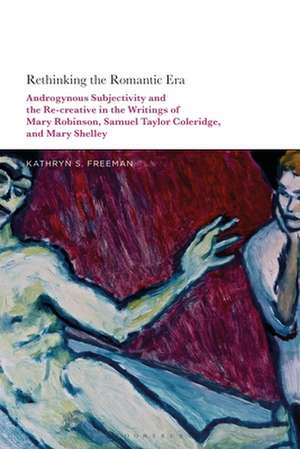Rethinking the Romantic Era: Androgynous Subjectivity and the Recreative in the Writings of Mary Robinson, Samuel Taylor Coleridge, and Mary Shelley
Autor Kathryn S. Freemanen Limba Engleză Hardback – 27 ian 2021
| Toate formatele și edițiile | Preț | Express |
|---|---|---|
| Paperback (1) | 196.08 lei 6-8 săpt. | |
| Bloomsbury Publishing – 24 aug 2022 | 196.08 lei 6-8 săpt. | |
| Hardback (1) | 567.48 lei 6-8 săpt. | |
| Bloomsbury Publishing – 27 ian 2021 | 567.48 lei 6-8 săpt. |
Preț: 567.48 lei
Preț vechi: 815.19 lei
-30% Nou
Puncte Express: 851
Preț estimativ în valută:
108.60€ • 112.96$ • 89.66£
108.60€ • 112.96$ • 89.66£
Carte tipărită la comandă
Livrare economică 12-26 aprilie
Preluare comenzi: 021 569.72.76
Specificații
ISBN-13: 9781350167407
ISBN-10: 1350167401
Pagini: 176
Dimensiuni: 156 x 234 x 18 mm
Greutate: 0.43 kg
Editura: Bloomsbury Publishing
Colecția Bloomsbury Academic
Locul publicării:London, United Kingdom
ISBN-10: 1350167401
Pagini: 176
Dimensiuni: 156 x 234 x 18 mm
Greutate: 0.43 kg
Editura: Bloomsbury Publishing
Colecția Bloomsbury Academic
Locul publicării:London, United Kingdom
Caracteristici
Dismantles traditional binaries separating the canonical and the noncanonical; male and female; poetry and prose; good and evil; subject and object
Notă biografică
Kathryn S. Freeman is Professor of English at the University of Miami, USA.
Cuprins
IntroductionChapter 1: Expansion and Contraction: Coleridge's Gendered Revolt against MaterialismChapter 2: Coleridge and Robinson: "Sense unchained"Chapter 3:Secondary Imagination, Contamination, and Androgyny: Christabel, Magnum Opus, and the Nature of EvilChapter 4: Re-thinking Literary Influence: Nondual Relationships of Gender and Generation in Robinson, Coleridge, Mary Wollstonecraft, and Mary Shelley BibliographyIndex
Recenzii
Although recognized as a major component of Romantic literature, story-telling has eluded the critical effort to identify the attributes that render it part of the crucial creative endeavor of the times. Kathryn S. Freeman identifies three traits in her subtitle: subjectivity, androgyny, and the recreative. She demonstrates their relevance by tracing the pervasive strategies of metanarrative, metatextuality, and metasexuality in the narratives of Mary Robinson, Samuel Taylor Coleridge, and Mary Shelley. Freeman is concerned with story-telling, similar to the author-character irony in Lord Byron's Childe Harold or Don Juan, in which the story-teller is a character in the story that he or she is telling, This "he or she" is further relevant to the metasexuality, for authors readily adopt an adapt alternate genders. Freeman reveals as well the tensions between the factual and fictional author, heightened by the metatextual intrusions of prefaces, footnotes, and cross-references. As dissimilar as these three authors might seem, all three implicate allusions and illusions on multiple levels of narrative. Freeman has effectively recontextualized the Romantic obsession with the creative imagination and subjective identity. Her attentive scrutiny of story-telling provides a valuable guide to Romantic narratology at large, applicable to every other story-teller of the period.
For those of us who teach and interpret Coleridge's poetry and works by women writers, Rethinking the Romantic Era is an engaging and valuable study.
For those of us who teach and interpret Coleridge's poetry and works by women writers, Rethinking the Romantic Era is an engaging and valuable study.
